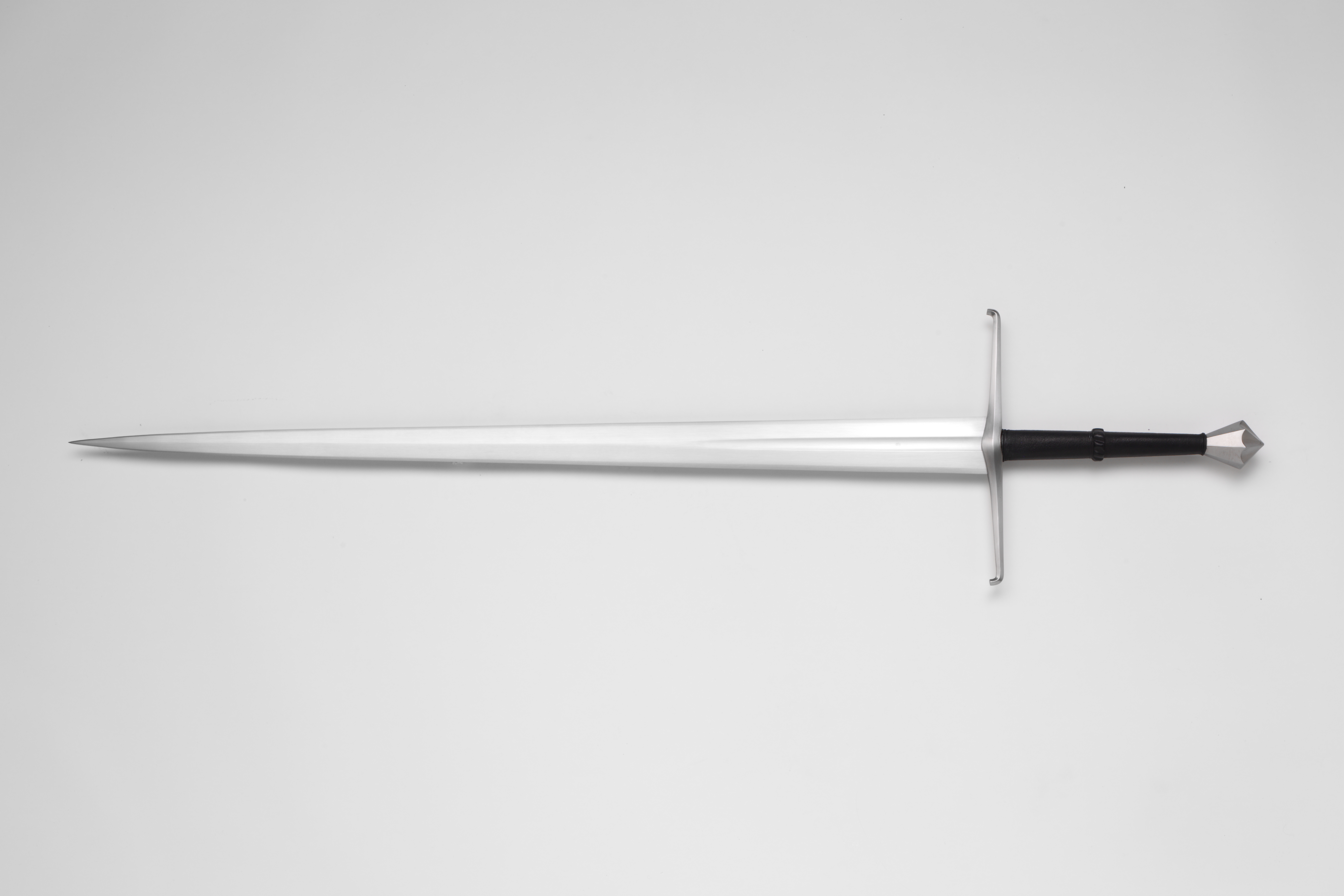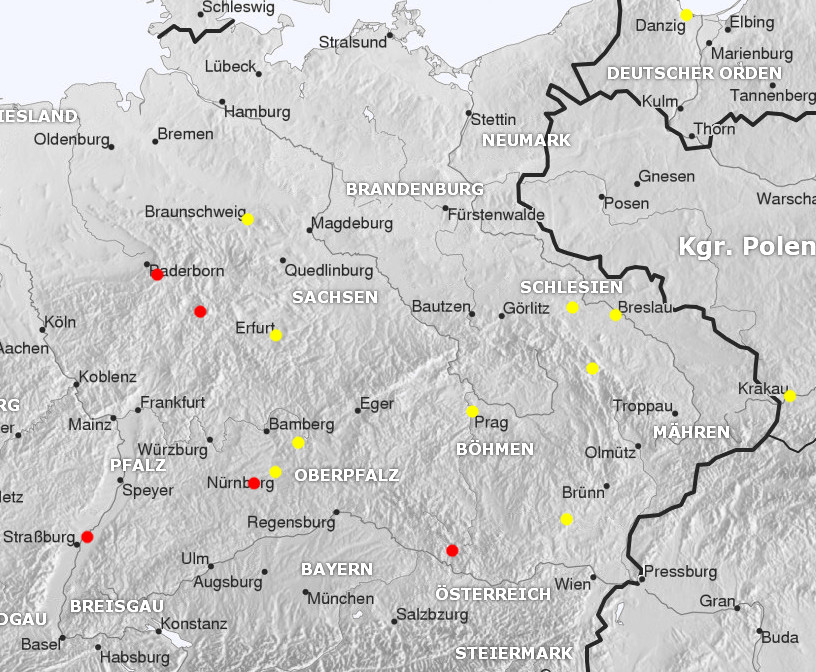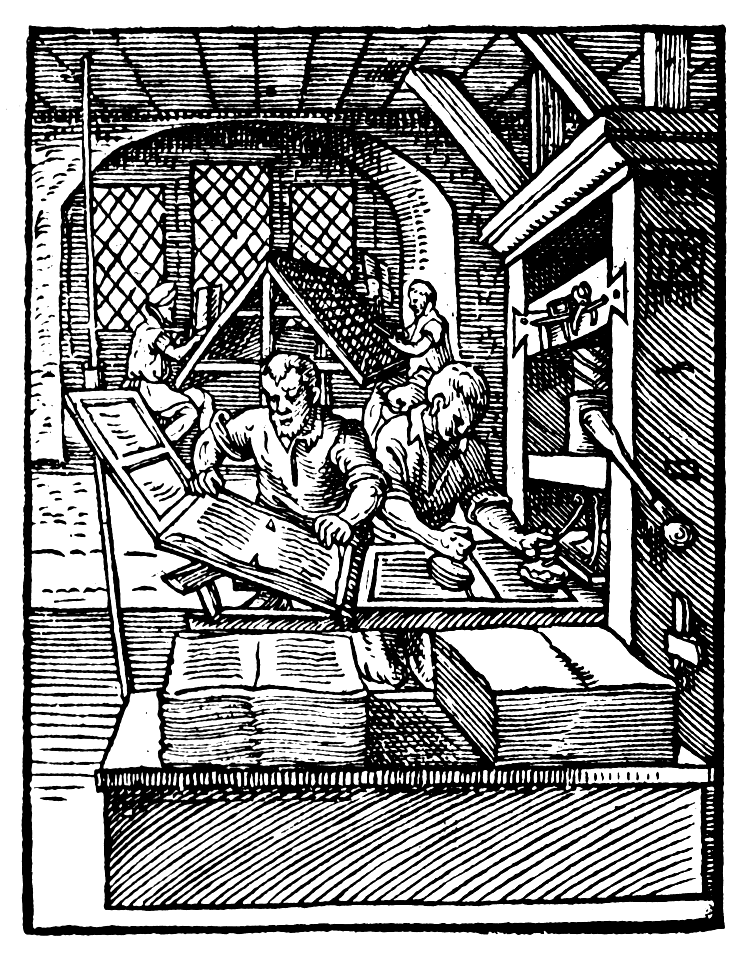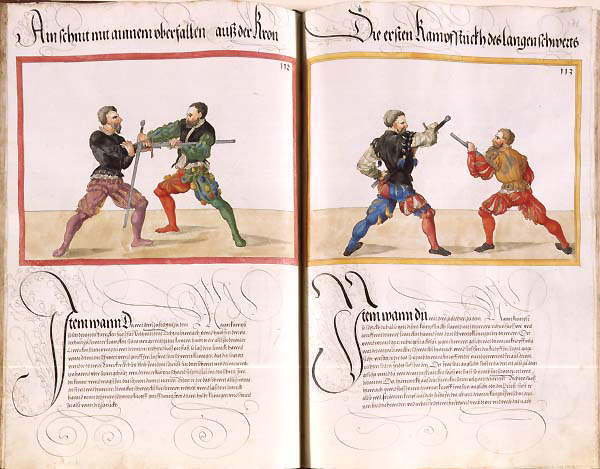|
Harnischfechten
The German school of fencing (') is a system of combat taught in the Holy Roman Empire during the Late Medieval, German Renaissance, and early modern periods. It is described in the contemporary Fechtbücher ("fencing books") written at the time. The geographical center of this tradition was in what is now Southern Germany including Augsburg, Frankfurt, and Nuremberg. During the period in which it was taught, it was known as the ', or the ''"Art of Fighting"''. The German school of fencing focuses primarily on the use of the two-handed longsword; it also describes the use of many other weapons, including polearms, medieval daggers, messers (with or without a buckler), and the staff, as well as describing mounted combat and unarmed grappling (''ringen''). Most authors of writings on the system are, or claim to be, in the tradition of the 14th-century master Johannes Liechtenauer. The earliest surviving treatise on Liechtenauer's system is a manuscript dated to possibly the la ... [...More Info...] [...Related Items...] OR: [Wikipedia] [Google] [Baidu] |
Longsword
A longsword (also spelled as long sword or long-sword) is a type of European sword characterized as having a cruciform hilt with a grip for primarily two-handed use (around ), a straight double-edged blade of around , and weighing approximately . The "longsword" type exists in a morphological continuum with the medieval knightly sword and the Renaissance-era Zweihänder. It was prevalent during the Late Middle Ages, late medieval and Renaissance periods (approximately 1350 to 1550), with early and late use reaching into the 11th and 17th centuries. Names English The longsword has many names in the English language, which, aside from variant spellings, include terms such as "bastard sword" and "hand-and-a-half sword." Of these, "bastard sword" is the oldest, its use being contemporaneous with the weapon's heyday. The French ' and the English "bastard sword" originate in the 15th or 16th century, originally in the general sense of "irregular sword, sword of uncertain orig ... [...More Info...] [...Related Items...] OR: [Wikipedia] [Google] [Baidu] |
Ringen
''Ringen'' is the German language term for grappling (wrestling). In the context of the German school of historical European martial arts during the Late Middle Ages and the German Renaissance, ''Ringen'' refers to unarmed combat in general, including grappling techniques used as part of swordsmanship. The German tradition has records of a number of master-''Ringer'' of the 15th to 16th centuries specializing in unarmed combat, such as Ott Jud. Medieval and early Renaissance wrestling treatises present both sport and combat techniques together as one art. The distinction is made more frequently by modern practitioners than is present in historical sources, but in a select few examples the terms for sportive grappling or ''geselliges Ringen'' and earnest unarmed combat or ''Kampfringen'' (where ''Kampf'' is the Early Modern German term for "war" or ''battle'') were used to describe specific techniques which were only suitable for one scenario or the other. There are no known s ... [...More Info...] [...Related Items...] OR: [Wikipedia] [Google] [Baidu] |
Johannes Liechtenauer
Johannes Liechtenauer (also ''Lichtnauer'', ''Hans Lichtenawer'') was a German Late Middle Ages, German fencing master who had a great level of influence on the German school of swordsmanship, German fencing tradition in the 14th century. Biography Liechtenauer seems to have been active during the mid-to-late 14th century in Germany, 14th century. The only extant biographical note on Liechtenauer is found in Nürnberger Handschrift GNM 3227a, GNM Hs. 3227a (dated c. 1400), which states that "Master Liechtenauer learnt and mastered [the art of the sword] in a thorough and rightful way, but he did not invent it or make it up himself, as it is stated before. Instead, he travelled across and visited many lands for the sake of this rightful and true art, as he wanted to study and know it." His German family names, surname indicates he was from a place called ''Liechtenau'' (modern ''Lichtenau''). There are several places with this name. Massmann (1844) mentions five candidate locatio ... [...More Info...] [...Related Items...] OR: [Wikipedia] [Google] [Baidu] |
Modern German
New High German (NHG; ) is the term used for the most recent period in the history of the German language, starting in the 17th century. It is a loan translation of the German (). The most important characteristic of the period is the development of a standard written German, followed by the standardisation of the spoken language. For this reason, the term New High German (or simply High German) is also used as a synonym for modern Standard German. Periodisation The German term was originally coined in 1819 by Jacob Grimm for the period from around 1450 to the present day, following on from Middle High German (). However, in 1878 Wilhelm Scherer proposed a transitional period, 1350–1650, for which he coined the new term (Early New High German), thus dating New High German from the mid 17th century. In spite of many alternative proposals, Scherer's remains the most widely adopted periodisation of German. There are both linguistic and extra-linguistic reasons for regarding th ... [...More Info...] [...Related Items...] OR: [Wikipedia] [Google] [Baidu] |
Frankfurt
Frankfurt am Main () is the most populous city in the States of Germany, German state of Hesse. Its 773,068 inhabitants as of 2022 make it the List of cities in Germany by population, fifth-most populous city in Germany. Located in the foreland of the Taunus on its namesake Main (river), Main, it forms a continuous conurbation with Offenbach am Main; Frankfurt Rhein-Main Regional Authority, its urban area has a population of over 2.7 million. The city is the heart of the larger Rhine-Main metropolitan region, which has a population of more than 5.8 million and is Germany's Metropolitan regions in Germany, second-largest metropolitan region after the Rhine-Ruhr metropolitan region, Rhine-Ruhr region and the List of EU metropolitan regions by GDP#2021 ranking of top four German metropolitan regions, fourth largest metropolitan region by GDP in the European Union (EU). Frankfurt is one of the ''de facto'' four main capitals of the European Union (alongside Brussels, Luxembourg Cit ... [...More Info...] [...Related Items...] OR: [Wikipedia] [Google] [Baidu] |
Nuremberg
Nuremberg (, ; ; in the local East Franconian dialect: ''Nämberch'' ) is the Franconia#Towns and cities, largest city in Franconia, the List of cities in Bavaria by population, second-largest city in the States of Germany, German state of Bavaria, and its 544,414 (2023) inhabitants make it the List of cities in Germany by population, 14th-largest city in Germany. Nuremberg sits on the Pegnitz (river), Pegnitz, which carries the name Regnitz from its confluence with the Rednitz in Fürth onwards (), and on the Rhine–Main–Danube Canal, that connects the North Sea to the Black Sea. Lying in the Bavarian Regierungsbezirk, administrative region of Middle Franconia, it is the largest city and unofficial capital of the entire cultural region of Franconia. The city is surrounded on three sides by the , a large forest, and in the north lies (''garlic land''), an extensive vegetable growing area and cultural landscape. The city forms a continuous conurbation with the neighbouring ... [...More Info...] [...Related Items...] OR: [Wikipedia] [Google] [Baidu] |
Early Modern German
Early New High German (ENHG) is a term for the period in the history of the German language generally defined, following Wilhelm Scherer, as the period 1350 to 1650, developing from Middle High German and into New High German. The term is the standard translation of the German (Frnhd., Fnhd.), introduced by Scherer. The term ''Early Modern High German'' is also occasionally used for this period (but the abbreviation EMHG is generally used for ''Middle High German, Early Middle High German''). Periodisation The start and end dates of ENHG are, like all linguistic periodisations, somewhat arbitrary. In spite of many alternative suggestions, Scherer's dates still command widespread acceptance. Linguistically, the mid-14th century is marked by the phonological changes to the vowel system that characterise the modern standard language; the mid-17th sees the loss of status for regional forms of language, and the triumph of German over Latin as the dominant, and then sole, language f ... [...More Info...] [...Related Items...] OR: [Wikipedia] [Google] [Baidu] |
Paulus Hector Mair
Paulus Hector Mair (1517–1579) was a German civil servant Historical European Martial Arts, fencing master from Augsburg. He collected Fechtbuch, Fechtbücher and undertook to compile all knowledge of the art of fencing in a compendium surpassing all earlier books. For this, he engaged the painter Jörg Breu the Younger, as well as two experienced fencers, whom he charged with perfecting the techniques before they were painted. The project was very costly, taking a full four years, and according to Mair, consumed most of his family's income and property. Three versions of his compilation, and one later, less extensive manuscript, have been preserved. Not only did Mair spend huge sums on his collections and on his projects, he also had a very expensive lifestyle, frequently hosting receptions for the more important Bourgeoisie#Middle Ages, burghers of Augsburg. His own income was not sufficient for this, and during many years, he misappropriated funds from the city treasury, with t ... [...More Info...] [...Related Items...] OR: [Wikipedia] [Google] [Baidu] |
Shakespeare
William Shakespeare ( 23 April 1564 – 23 April 1616) was an English playwright, poet and actor. He is widely regarded as the greatest writer in the English language and the world's pre-eminent dramatist. He is often called England's national poet and the " Bard of Avon" or simply "the Bard". His extant works, including collaborations, consist of some 39 plays, 154 sonnets, three long narrative poems and a few other verses, some of uncertain authorship. His plays have been translated into every major living language and are performed more often than those of any other playwright. Shakespeare remains arguably the most influential writer in the English language, and his works continue to be studied and reinterpreted. Shakespeare was born and raised in Stratford-upon-Avon, Warwickshire. At the age of 18, he married Anne Hathaway, with whom he had three children: Susanna, and twins Hamnet and Judith. Sometime between 1585 and 1592 he began a successful career in Lon ... [...More Info...] [...Related Items...] OR: [Wikipedia] [Google] [Baidu] |









